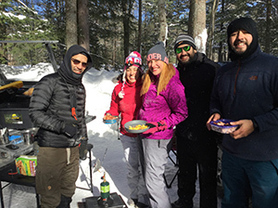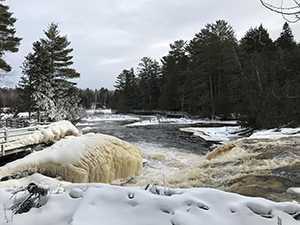Coming to a state park this winter? Come prepared
By THERESA NEAL
Michigan Department of Natural Resources
Dealing with mild winter conditions is sometimes more challenging than preparing for a whole lot of cold and snow.
A trio of visitors to Tahquamenon Falls State Park in the eastern Upper Peninsula were reminded of this recently when a hike on a relatively mild winter day turned into a hazardous situation.
The incident underscores the importance of being prepared for the location and the wintertime conditions.
Early winter rain showers had produced a sheet of ice that covered 4 inches of snow. This frosty glaze encased park features, including the 4-mile-long trail between the spectacular Upper and Lower Tahquamenon Falls.
 Three young men who attempted the trail hike became stranded along the banks of the wide, winding river. After sliding down an embankment, they were unable to get back up.
Their call to 9-1-1 from the remote location went through. With flashlights in hand, park rangers and emergency personnel soon began their own trek to try to rescue the men.
Sheriff’s deputies and EMS workers were there, along with state police troopers and the U.S. Border Patrol. All were risking their own safety to affect the rescue of the men.
“The trail was covered in glare ice, especially the stairways,” said Eric Johnson, a park officer who led the rescue effort. “Despite walking slowly and carefully, we all fell multiple times. The ice, plus pitch darkness and cold temperatures, made for a treacherous situation.”
After two hours, the three men were located, stranded at the bottom of an icy ridge. One man was showing signs of hypothermia, including confusion and fatigue, and was struggling to move.
Emergency personnel formed a human chain to pull the men away from the river. They used ropes to get everyone to the relative safety of the embankment.
“Fortunately, this situation has a positive ending. Park rangers are familiar with the terrain and were able to organize the search efficiently by asking the right questions to figure out where the men were along the trail,” said Tahquamenon Falls State Park Manager Kevin Dennis. “Without park rangers assisting with the search, these visitors would have been exposed to the cold even longer, with potentially dire consequences.”
|
 Even mildly cold environments can lead to hypothermia. Symptoms of exposure to cold conditions develop quickly, including shivering, shallow breathing, confusion and loss of coordination.
All these concerns can be avoided by wearing proper clothing and layering.
Use the following checklist to dress before winter activities:
-
No cotton touching skin: The key is to avoid cotton materials. Cotton will absorb sweat and water and stay wet, causing a person to become cold. Start with a polyester blend, or merino wool, as a first layer, which will provide heat even when wet.
-
Fleece or wool sweater: Follow that first non-cotton layer up with one or two layers of insulation, such as a fleece or wool sweater.
-
Wind/waterproof jacket: The top layer should be waterproof or water resistant. A rain jacket, that can be unzipped after warming up during outdoor activity is ideal.
-
Hat, gloves or mittens: A hat and gloves are important for any winter activity. Mittens are best for those who tend to get cold fingers. If people get warm, they can always take their hat and gloves off for a few minutes – they may be amazed at how quickly they cool off.
-
Warm footwear: Footwear should also start with a non-cotton sock. Wool or polypropylene socks are soft, warm and lightweight. They don’t bunch up inside boots and will keep feet warm, even if sweating. Winter boots or waterproof hiking boots are necessary. Ice-traction devices can be invaluable during mild winters, which are often characterized by icy conditions.
-
Snow pants or gaiters: Snow pants are great for cold weather, but some people opt to wear gaiters, which fit over boots and cover pants up to the knee. Gaiters keep snow and water out of boots without the bulkiness of snow pants.
Beyond dressing properly, tell someone where you are going and when you plan to return. Leave a note, a text or a voicemail.
“Visitors to the most wintry of our Michigan state parks should be prepared for conditions when they arrive, even if they only plan to stay a few minutes,” said John Pepin, DNR deputy public information officer. “A quick walk to a scenic vista could become a serious situation if unexpected circumstances occur, perhaps leaving a person injured or stranded, unprepared to deal with nature’s elements.”
|
 Not all of Michigan’s 103 state parks have the steep terrain of the Porcupine Mountains, or the inherent danger of the Upper Tahquamenon Falls, but all the parks possess the potential for serious challenges for visitors who arrive unprepared to deal with a variety of changing weather-related conditions.
Visitors should make sure vehicles are packed for an emergency during winter adventures. Bring a shovel, blankets, a bucket of sand or cat litter for traction, a flashlight, water and snacks. These items can help drivers remove a vehicle from a ditch or snowbank or make the wait for help to arrive more tolerable.
“Our park is open year-round, so people can experience the waterfalls in the winter,” Dennis said. “We encourage visitors to do their part and come prepared for winter conditions. This way, they can enjoy their visit, and everyone can stay safe.”
The River Trail at Tahquamenon Falls State Park is now closed due to unsafe conditions until further notice.
Get additional winter safety tips in this video with DNR Conservation Officer Jennifer Hanson, who patrols in Gogebic County.
|
Check out previous Showcasing the DNR stories in our archive at michigan.gov/dnrstories. To subscribe to upcoming Showcasing articles, sign up for free email delivery at michigan.gov/dnr.
/Note to editors: Contact: John Pepin, Showcasing the DNR series editor, 906-226-1352. Accompanying photos and a text-only version of this story are available below for download. Caption information follows. Credit Michigan Department of Natural Resources, unless otherwise noted.
Text-only version of this story.
Campers: Winter campers enjoy breakfast at Tahquamenon Falls State Park in the eastern Upper Peninsula.
Closed: The Trail Between the Falls at Tahquamenon Falls State Park in the eastern Upper Peninsula is closed until further notice.
Lower: The Lower Tahquamenon Falls, shown here, are a beautiful eastern Upper Peninsula place to visit at any time of the year.
Trail: The Trail Between the Falls at Tahquamenon Falls State Park in the eastern Upper Peninsula follows the river for 4 miles.
Upper: The Upper Tahquamenon Falls in the eastern Upper Peninsula are shown on a cold January day./
|